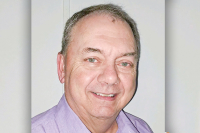Lake Junaluska’s bold new plan to reclaim its future
 Lake Junaluska Conference and Retreat Center has unveiled a $40 million, 10-year campus master plan in hopes of bolstering convention business and attracting a new breed of resort tourist.
Lake Junaluska Conference and Retreat Center has unveiled a $40 million, 10-year campus master plan in hopes of bolstering convention business and attracting a new breed of resort tourist.
Lake Junaluska merger with Waynesville sails through Senate
A state bill that would bring Lake Junaluska into Waynesville’s town limits has cleared the N.C. Senate and is now headed for passage in the N.C. House of Representatives.
The Lake Junaluska Conference and Retreat Center and the 760-home residential community surrounding it would then be absorbed into Waynesville’s town limits by late summer.
World Methodist leader overcomes adversity in his life path to Junaluska
 Ivan Abrahams didn’t come to hold the top spot in the World Methodist Council because he abided by the rules. At more than one point in his spiritual career, he was a bit of a thorn in the clergy’s side.
Ivan Abrahams didn’t come to hold the top spot in the World Methodist Council because he abided by the rules. At more than one point in his spiritual career, he was a bit of a thorn in the clergy’s side.
Friends of the Lake launched to support walking path
 Ed Green has plenty of time for contemplation during his 15 mile runs on the paths circling Lake Junaluska. One of his recurring thoughts turns to what’s underfoot: how lucky he is to run in such a beautiful place.
Ed Green has plenty of time for contemplation during his 15 mile runs on the paths circling Lake Junaluska. One of his recurring thoughts turns to what’s underfoot: how lucky he is to run in such a beautiful place.
Tide of support carries Lake Junaluska, Waynesville toward merger
 Lake Junaluska homeowners and community leaders spoke out strongly last week in favor of merging with Waynesville, setting the stage for a bill to work its way through the N.C. General Assembly this summer declaring Lake Junaluska part of the town of Waynesville.
Lake Junaluska homeowners and community leaders spoke out strongly last week in favor of merging with Waynesville, setting the stage for a bill to work its way through the N.C. General Assembly this summer declaring Lake Junaluska part of the town of Waynesville.
Emotions run high as Lake Junaluska task force votes for merger
 A Lake Junaluska task force voiced overwhelming support last week for merging the 765-home community with the town of Waynesville before a packed audience of homeowners.
A Lake Junaluska task force voiced overwhelming support last week for merging the 765-home community with the town of Waynesville before a packed audience of homeowners.
SEE ALSO: Ongoing coverage
The 14-member task force has spent 10 months weighing the future course of the community with century-old roots as a summer Methodist retreat. Financial solvency was the deciding factor for those in favor of being absorbed into Waynesville’s town limits. The community does not have the critical mass nor economies of scale to go it alone, especially given the costly repairs it would face during the next decade to fix its crumbling infrastructure, task force members said.
Taking the polar plunge
 Around 30 daring souls splashed and jumped into Lake Junaluska last Saturday for the first annual “Polar Plunge” to raise money for Haywood Waterways Kids in the Creek program.
Around 30 daring souls splashed and jumped into Lake Junaluska last Saturday for the first annual “Polar Plunge” to raise money for Haywood Waterways Kids in the Creek program.
Lake Junaluska a good catch for Waynesville, but light on the dowry
 Adding Lake Junaluska to its town limits won’t be a windfall for Waynesville despite $775,000 in property taxes it stands to gain each year. Likewise, Junaluska wouldn’t be a financial drain on the town, according to the results of a highly anticipated engineering and feasibility study outlining the pros and cons of a merger.
Adding Lake Junaluska to its town limits won’t be a windfall for Waynesville despite $775,000 in property taxes it stands to gain each year. Likewise, Junaluska wouldn’t be a financial drain on the town, according to the results of a highly anticipated engineering and feasibility study outlining the pros and cons of a merger.
A match made in heaven?
Waynesville Mayor Gavin Brown has honed his dating and engagement analogies as town leaders weigh whether to tie the knot with Lake Junaluska.
They started innocently enough 10 months ago.
Countdown to decision time
Several boards and bodies will formally vote in coming weeks on whether Lake Junaluska should become part of Waynesville, form its own town or continue as a sophisticated homeowner’s association. Here’s a look at who will be weighing in and when.
SEE ALSO: Ongoing coverage
February 22: Public hearing by Waynesville leaders. 11 a.m. at new town hall.
February 26: Waynesville Board of Alderman votes. 7 p.m. at town hall. Alternate date first week of each month.
February 28: Property owner survey results announced. 7 p.m. at Harrell Center at Lake Junaluska.
February 28: Lake Junaluska task force votes. 7 p.m. at the Harrell Center at Lake Junaluska.
March 5: Lake Junaluska Community Council votes. 4 p.m. at Junaluska Welcome Center
March 8: Lake Junaluska Board of Directors votes. No time specified.
March 13: General Assembly deadline for bill to be introduced. Vote by state lawmakers by late summer.









